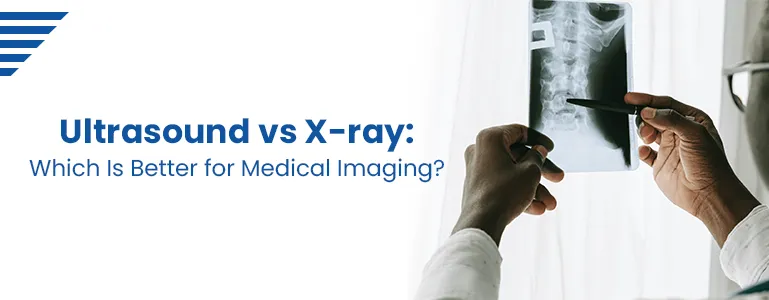Ultrasound vs. X-ray: Which Is Better for Medical Imaging

Introduction
Medical imaging plays a crucial role in diagnosing and monitoring a wide range of medical conditions. Among the most common imaging techniques are ultrasound and X-ray. Both methods provide valuable insights into the human body, but they differ significantly in terms of their principles, applications, and safety profiles. In this blog, we'll explore the differences between ultrasound and X-ray imaging and help you understand which one might be better suited for specific medical situations.
Home Sample Collection
Understanding Ultrasound Imaging
Ultrasound imaging, also known as sonography, relies on sound waves to create real-time images of the body's internal structures. Here's how it works:
Sound Waves: A small handheld device called a transducer emits high-frequency sound waves into the body.
Reflection: When these sound waves encounter different tissues and organs, they bounce back (reflect) at varying speeds depending on the density of the tissues.
Image Formation: The transducer collects the reflected waves and sends them to a computer, which processes the data to create dynamic images on a screen.
Applications of Ultrasound
Obstetrics: Ultrasound is commonly used during pregnancy to monitor fetal development.
Abdominal Imaging: It helps diagnose conditions in the liver, gallbladder, pancreas, and other abdominal organs.
Cardiac Imaging: Echocardiograms use ultrasound to assess heart function.
Musculoskeletal Imaging: It aids in diagnosing soft tissue injuries and joint conditions.
Understanding X-ray Imaging
X-ray imaging, on the other hand, uses ionizing radiation to produce detailed images of the body's interior. Here's how it works:
X-ray Machine: A machine emits a controlled amount of X-ray radiation through the body.
Absorption: Dense structures, like bones and tumors, absorb more X-rays, resulting in white areas on the X-ray image.
Image Capture: X-rays that pass through the body are captured on a detector, creating an image.
Applications of X-ray
Orthopedics: X-rays are commonly used to detect fractures, bone diseases, and joint problems.
Dental: Dental X-rays are essential for diagnosing oral health issues.
Chest Imaging: It helps diagnose lung conditions like pneumonia and lung cancer.
Mammography: X-ray mammography is used for breast cancer screening.
Comparing Ultrasound and X-ray
Now that we've discussed how both imaging techniques work, let's compare them based on various factors:
Radiation Exposure: Ultrasound does not use ionizing radiation, making it safer for pregnant women and children. X-rays, on the other hand, expose patients to a small dose of ionizing radiation.
Image Clarity: X-rays provide detailed images of bones and dense tissues, making them suitable for orthopedics and dentistry. Ultrasound excels in visualizing soft tissues, such as organs and muscles.
Real-Time Imaging: Ultrasound offers real-time imaging, making it ideal for monitoring moving structures, like a beating heart or a developing fetus. X-rays typically produce static images.
Portability: Ultrasound machines are often portable, allowing for use in various healthcare settings, including remote areas. X-ray machines are bulkier and less portable.
Cost: Ultrasound is generally more cost-effective than X-ray imaging.
Conclusion
The choice between ultrasound and X-ray imaging depends on the specific medical situation and the information needed. Ultrasound is excellent for visualizing soft tissues and moving structures without exposing patients to ionizing radiation. In contrast, X-rays are preferred when detailed images of bones and dense structures are necessary.
Ultimately, the decision should be made by healthcare professionals based on the patient's condition and the diagnostic requirements. Both ultrasound and X-ray imaging play vital roles in modern medicine, contributing to accurate diagnoses and improved patient care.
Frequently Asked Questions
What is the fundamental difference between ultrasound and X-ray imaging?
Ultrasound relies on high-frequency sound waves to create real-time images of soft tissues, while X-ray imaging uses ionizing radiation to produce detailed images of bones and dense structures.
Are ultrasound and X-ray equally safe for medical imaging?
No, there's a significant difference in safety. Ultrasound does not use ionizing radiation and is considered safe for all patient groups, including pregnant women and children. X-ray imaging exposes patients to ionizing radiation, which can pose health risks with repeated exposure.
Which imaging method is better for visualizing soft tissues like organs and muscles?
Ultrasound is better suited for visualizing soft tissues and organs because it excels at differentiating between different densities of tissues, providing detailed images of structures like the liver, kidneys, and heart.
When is X-ray imaging preferred over ultrasound?
X-ray imaging is preferred when detailed images of bones, such as fractures or joint issues, are needed. It is also used for dental and chest imaging to diagnose conditions like lung diseases and dental problems.
Can ultrasound provide real-time imaging, and if so, in what medical situations is this advantageous?
Yes, ultrasound provides real-time imaging, making it ideal for monitoring moving structures, such as a beating heart, developing fetus during pregnancy, and assessing blood flow. This real-time capability is advantageous for diagnostics and procedures that require dynamic visualization.
Which imaging method is more cost-effective, ultrasound, or X-ray?
Generally, ultrasound is more cost-effective than X-ray imaging. Ultrasound machines are often less expensive, and the procedure itself typically incurs lower costs.
Are there situations where both ultrasound and X-ray may be used together for a more comprehensive diagnosis?
Yes, in some cases, healthcare providers may use both ultrasound and X-ray imaging to complement each other's strengths. For instance, during orthopedic evaluations, an X-ray can identify a bone fracture, while ultrasound can assess soft tissue damage in the same area.
Book Appointment
Our Locations Near You in Hyderabad
3KM from Banjara Hills
1.9KM from Yusufguda
3KM from Madhura Nagar
5KM from Shaikpet




